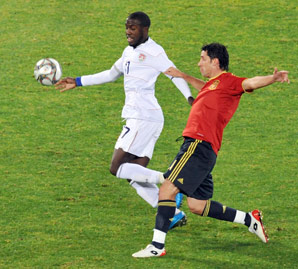U.S. team, an improved MLS fuel growing buzz for sport in America
"I'm not sure if it is that I'm looking at things from a different perspective lately, but we are witnessing a Movement of Soccer Consciousness," he wrote.
Believing that the "soccer consciousness" is growing here in the States has always been hard for those of us who have long been part of the struggle. We've been seared too many times: the NASL's crash, the slow-burn promise of the 1994 World Cup, false prophets like Lothar Matthäus, Denílson and RuudGullit. But I have to agree with my friend. There is a movement afoot.
It started, I suppose, with the Americans' run at the Confederations Cup. Then Oguchi Onyewu signed with AC Milan, signaling that U.S. players could be desired commodities at the upper echelons of the game. The momentum continued with Grant Wahl's bombshell of a book on David Beckham, The Beckham Experiment. Now there is the U.S. team's Gold Cup adventure and, next month, the massive World Cup qualifier against Mexico at the Estadio Azteca.
But for the surest evidence, look no further than the calendar of international friendlies taking place here this summer -- and the reaction they've been getting (and will continue to get).
At the beginning of the decade, European teams barnstormed here regularly. They'd come play friendlies against MLS teams or against each other. These were basically money-making boondoggles, extended vacations that let the players escape the stress of the domestic press and the home fans.
But the soccer suffered. The MLS teams weren't good enough to compete -- or even to make it difficult -- and the crowds would eschew their home team to cheer for the marquee names on the visiting side. Soon people stopped coming. Who can blame them? Who wants to watch a vacationing "B" squad against a poor MLS team, all while there are American football lines on the field? I'm a soccer junkie, but that was ridiculous.
On Saturday, though, the Seattle Sounders took on Chelsea FC and nothing was ridiculous (except maybe that catfight between the referee and JulianoBelletti). A standing-room only crowd of 65,289 packed into Qwest Field as tightly as espresso grounds, and though the home team lost 2-0 -- not an unexpected result considering Seattle's annual payroll is roughly one-third of John Terry's salary -- for once the bold-faced guests didn't get the cheers.
On Sunday, more than 30,000 people saw Club América draw with Inter Milan as the World Football Challenge kicked off in Palo Alto, Calif. Sunday night, a packed house of 27,000 witnessed a thrilling 2-2 draw between AC Milan and the Los Angeles Galaxy in Carson, Calif. Everyone loves a little Beckham drama.
So what's changed? Why is this summer's soccer feast tastier than previous ones? Well, part of it is the mood swing brought on by the aforementioned events. But, more important, it comes down to the football. As always.
Simply put, the MLS teams are better than they used to be, and their fan bases are more ingrained than before. No, I'm not saying the Galaxy are on par with Milan just because they drew. After all, these are friendlies. But unlike before, the visitors can get something even more valuable than marketing hype and a fistful of merchandising dollars. They can get some good preseason competition, a fact that makes the games much more appealing to fans.
Furthermore, with young American players beginning to show great potential in Europe, these big sides are here to establish ties with MLS clubs and/or big youth clubs, such as Chelsea's relationship with the Los Angeles Futbol Club and others. They know that the next Lionel Messi or Ronaldo could possibly emerge from the youth ranks in the U.S. They want to make sure they have their hands in the cookie jar when that starlet appears on the scene.
That's the glorious future, of course -- the first American superstar. This Movement of Soccer Consciousness is the fuel for that, and it does seem to be growing. But there is one question for my friend at the bid committee, and for all of us: Where will it be when the U.S. next hosts the World Cup?





